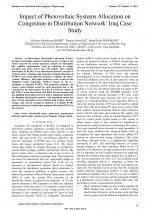| 2/2022 - 10 | View TOC | « Previous Article | Next Article » |
Impact of Photovoltaic Systems Allocation on Congestion in Distribution Network: Iraq Case StudyBADR, H. M. |
| View the paper record and citations in |
| Click to see author's profile in |
| Download PDF |
Author keywords
distributed power generation, optimization methods, photovoltaic systems, power demand, voltage control
References keywords
distribution(11), optimal(10), generation(10), power(9), photovoltaic(9), algorithm(9), solar(7), location(7), distributed(7), systems(6)
Blue keywords are present in both the references section and the paper title.
About this article
Date of Publication: 2022-05-31
Volume 22, Issue 2, Year 2022, On page(s): 79 - 86
ISSN: 1582-7445, e-ISSN: 1844-7600
Digital Object Identifier: 10.4316/AECE.2022.02010
Web of Science Accession Number: 000810486800010
SCOPUS ID: 85131723748
Abstract
As Photovoltaic Distributed Generation (PVDG) becomes increasingly popular in modern power systems, it has raised concerns for system operators, despite its remarkable and valuable opportunities, such as reduction in voltage deviation and active power loss. On another side, random distribution of PVDGs in the distribution network can lead to system security violations and congestion. Optimal allocation of PVDGs is one of the efficient methods to enhance the power systems' efficiency. This paper proposes a new version of the Modified Camel Algorithm (NMCA) based on the L technique to optimize PVDGs. The proposed technique can retain a good solution group for each generation due to the expansion in the search space. In order to verify the validity of the NMCA, it has been tested with IEEE 69- bus network and the Baghdad distribution network built a simulation model for the Baghdad distribution network. The simulation model has been created depending on its obtained load profiles, feeders, voltage, and current settings in addition to available PVDG stations in this grid to determine optimum allocation PVDGs in the network. |
| References | | | Cited By |
Web of Science® Times Cited: 0
View record in Web of Science® [View]
View Related Records® [View]
Updated 2 days, 22 hours ago
SCOPUS® Times Cited: 0
View record in SCOPUS® [Free preview]
There are no citing papers in the CrossRef Cited-by Linking system.
Disclaimer: All information displayed above was retrieved by using remote connections to respective databases. For the best user experience, we update all data by using background processes, and use caches in order to reduce the load on the servers we retrieve the information from. As we have no control on the availability of the database servers and sometimes the Internet connectivity may be affected, we do not guarantee the information is correct or complete. For the most accurate data, please always consult the database sites directly. Some external links require authentication or an institutional subscription.
Web of Science® is a registered trademark of Clarivate Analytics, Scopus® is a registered trademark of Elsevier B.V., other product names, company names, brand names, trademarks and logos are the property of their respective owners.
Faculty of Electrical Engineering and Computer Science
Stefan cel Mare University of Suceava, Romania
All rights reserved: Advances in Electrical and Computer Engineering is a registered trademark of the Stefan cel Mare University of Suceava. No part of this publication may be reproduced, stored in a retrieval system, photocopied, recorded or archived, without the written permission from the Editor. When authors submit their papers for publication, they agree that the copyright for their article be transferred to the Faculty of Electrical Engineering and Computer Science, Stefan cel Mare University of Suceava, Romania, if and only if the articles are accepted for publication. The copyright covers the exclusive rights to reproduce and distribute the article, including reprints and translations.
Permission for other use: The copyright owner's consent does not extend to copying for general distribution, for promotion, for creating new works, or for resale. Specific written permission must be obtained from the Editor for such copying. Direct linking to files hosted on this website is strictly prohibited.
Disclaimer: Whilst every effort is made by the publishers and editorial board to see that no inaccurate or misleading data, opinions or statements appear in this journal, they wish to make it clear that all information and opinions formulated in the articles, as well as linguistic accuracy, are the sole responsibility of the author.





